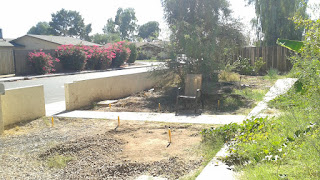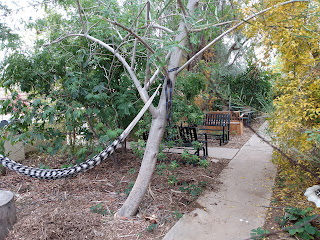In
part 1 and
part 2 I gave two different conceptions of the term "food
forest" that I have held and described how the difference in definition
resulted in different approaches to starting the food forest. Now I'll
describe some experimental strategies we used in our second section of
food forest and list our plant palette of support species.
But before I do that, here are a few brief philosophical observations about the these two approaches.
I
would say our second approach focuses more attention under the surface
of the soil. I don't mean this as a categorical distinction, but more
as a matter of relative degree. The first approach also relies on and
intentionally cultivates subsurface life, but it puts a greater emphasis
on supersurface production from the very beginning, where the second
focuses more below the soil first and defers (again, relatively) focus
on production.
The second approach shifts more of the work (e.g.
importing mulch, applying fertilizer) and more of the "determination"
(e.g. what to plant where and when) from the humans to the plants.
The first approach involves more development by building, and the
second, more
development by growing. Again, this is a matter of
relative degree. In the first approach, parts (trees) are developed
(partially anyway) offsite and then assembled onsite; fertilizer (at
least the first application) is generated offsite and then imported and
applied; and the the placement of all plants is effected by a human
agent. In the second, all parts at all scales are developed
simultaneously
in situ, and the placement (after thinning) will
be influenced - even if not strictly determined - by how seeds land and
which locations offer ideal growing conditions.
I often make the
point that development by growing results in a product that emulates a
living (biological) system, but more than that, I think it's a requisite
to mastery. Not that I'm a master at cultivating a food forest or even
at gardening, but I can master being while I commit myself to the act
of cultivating a food forest, thanks to development by growing, and
thereby approach mastery of the act.
I said "brief" so let's get on with strategies.
Bermuda
grass grows very quickly throughout most of the year in our climate.
For better or worse, we take intentional strategies to grow in spite of
it. Here are some strategies we have used at Sage Gardens, ordered from
most passive to most active:
- Deny it water (and cut it when it grows long)
- Shade it out with plants
- Smother it with mulch
- Dig it out
By the way, two other strategies to deal with grass that I like but haven't practiced at Sage Garden are grazing and solarizing.
In
the area surrounding the second section of food forest, we'll simply
deny Bermuda grass water, and inside the food forest, we should have a
canopy to shade it out pretty quickly. The anticipated problem is along
the edge, where grass can send leaves to get sunlight from the outside
and send roots to get water from the inside. Without some strategy for
the edge, Bermuda grass might rob the trees of water and nutrients. We
used two "edge strategies" to avoid this.
 Edge strategy 1: smother
Edge strategy 1: smother
Along
a 17 ft portion of the edge is where a future arroyo is planned. In
order to get the food forest seeded right away (to take advantage of
forecasted rain), we postponed digging the arroyo and "reserved" the
space using contractor paper - a trick I took from James Prigione's food
forest videos on YouTube. We covered the paper with straw mulch to
weigh it down and make it look nice.
Edge strategy 2: shade
Along
the rest of the edge, we heaped sweet potato vines. This time of year
we have an overabundance of sweet potato vines going dormant. If some
of these survive the winter (when the Bermuda grass is also dormant),
they should sprint into action in the spring, shading any grass within
several feet, and providing edible leaves and tubers.
Strategy: drip tube and valves
We tied into an existing
irrigation line we were already using for more frequent watering, and
ran two lines of drip tube, each 15 ft long, over the new forest area.
The drip tube has 0.6 gph emitters spaced at 1 ft, so in the two hour
duration that we run this irrigation zone, this 70 sq ft area will get
about 36 gallons. Each of the two drip tube lines has its own shutoff
valve (a simple 1/2" inline manual valve) to give us options if we want
to cut the water volume in half later, or plant a "row" of veggies along
one or both of the tubes.
Strategy: early canopy
I mentioned in part 2 that we're planting very densely with some fast-growing plants in order to form a low but tight protective canopy within 3-4 months. This strategy is taken from Geoff Lawton's video "Establishing a Food Forest."
Strategy: plant by seed
Eight of the nine species of plants we planted in the new section of food forest were planted by seed. Four of those species are from seeds we collected onsite (for free). This strategy allows us to plant potentially (dependent on germination rates) 500 plants for a cost of about $25. This makes it economically feasible 1) to employ our "early canopy" strategy, and 2) to overplant in compensation for my inexperience. As I gain more knowledge and experience, I'll be able to get the same results with fewer seeds, but for now, I'm starting as I am. We had a mix of large seeds of small quantities and small seeds of large quantities, so we first planted the large seeds under the surface, and then scattered the small seeds, to be covered later with straw mulch. We used this order to avoid accidentally picking up small seeds on our shoes while we planted large seeds.
Strategy: let the plants do the work
We're relying heavily on our pioneer plants to 1) convert atmospheric nitrogen and other gases into bioavailable subsurface fertilizer, 2) convert water and atmospheric carbon dioxide into woody mulch, 3) regulate soil temperature and moisture by physically covering it, and 4) aerate the soil. This strategy is inspired by the permaculture principle that "everything gardens."
Strategy: no dig, no amendments
We didn't till or amend our soil in any way. We selected pioneer plants that can grow quickly in poor soil. Honestly, the labor and cost to till and add amendments isn't prohibitive on this small scale, but we want to learn a way that can be upscaled. This strategy is inspired by Masanobu Fukuoka's concept of do-nothing farming.
Strategy: legume seed + inoculant
Seven of the nine species are legumes planted by seed (and an eighth, moringa, although it isn't technically a legume also forms a symbiotic association with nitrogen-fixing bacteria). We coated these seeds before planting with inoculants containing high concentrations of the rhizobium bacteria that will later cooperate with their roots to fix atmospheric nitrogen in the soil. These bacteria are naturally occurring in the soil, but by inoculating the seeds, we hope to jump-start the nitrogen fixing process.
Strategy: fungus selection
I don't know yet whether this will work, but we intentionally started mushrooms of a species that 1) can thrive and hold its own in a Phoenix urban forest microclimate (without being picky about what it eats), 2) isn't parasitic, and 3) has delicious fruiting bodies. For us, that translated into oyster mushrooms. Since this species is saprophytic, it will start its life eating our straw mulch and later eat pruned branches. And whatever it eats it will turn into food, either for humans or for subsurface organisms that will feed the trees.
Strategy: plant selection
Here are the criteria we used to select plants:
- Must grow in poor soil
- Must have mix of forms: some trees, some bushes, some ground covers
- Prefer nitrogen-fixing plants
- Prefer fast growers
- Prefer native plants, followed by desert adapted
- Prefer seeds we can collect from existing plants onsite
- Prefer trees that can be pollarded or coppiced
All of which led us to the following plant selection for this section of food forest:
| Plant Form |
Native Species |
Adapted Species |
Other Species |
| Tree |
10 sweet acacias
Acacia farnesiana |
35 leucaenas
Leucaena leucocephala |
15 moringas
Moringa oleifera |
| Bush |
35 pink fairy dusters
Calliandra eriophylla |
35 baja fairy dusters
Calliandra californica |
|
| Ground |
200 lupines
Lupinus arizonicus |
25 trailing acacias
Acacia redolens |
200 common vetch
Vicia sativa
8 sweet potatoes
Ipomoea batatas |















































